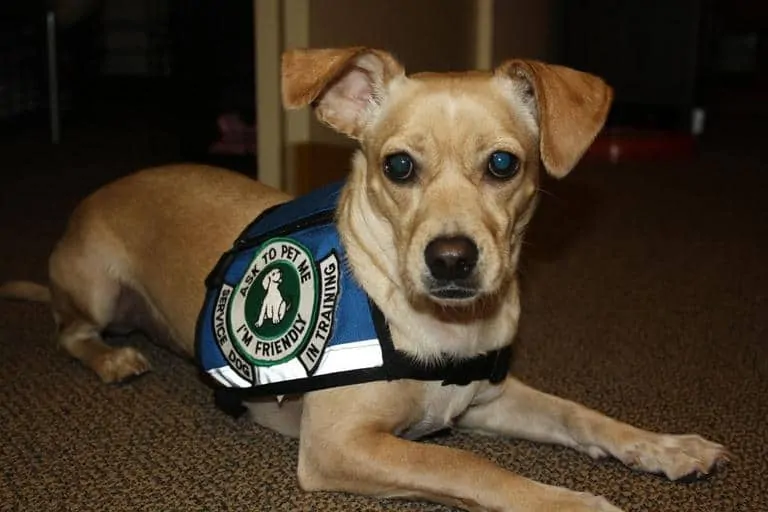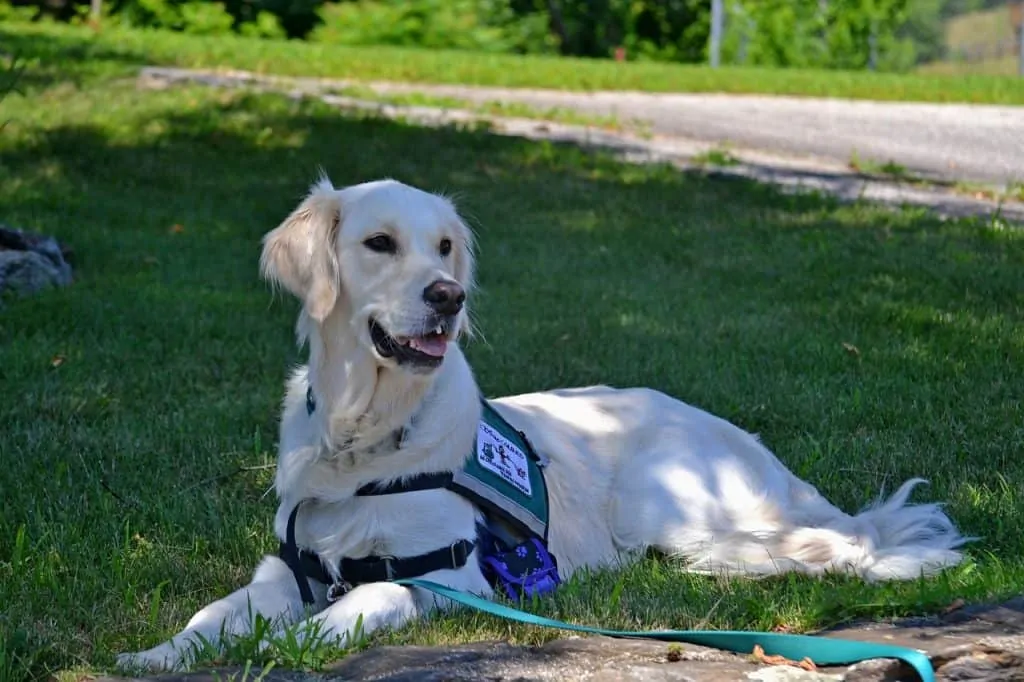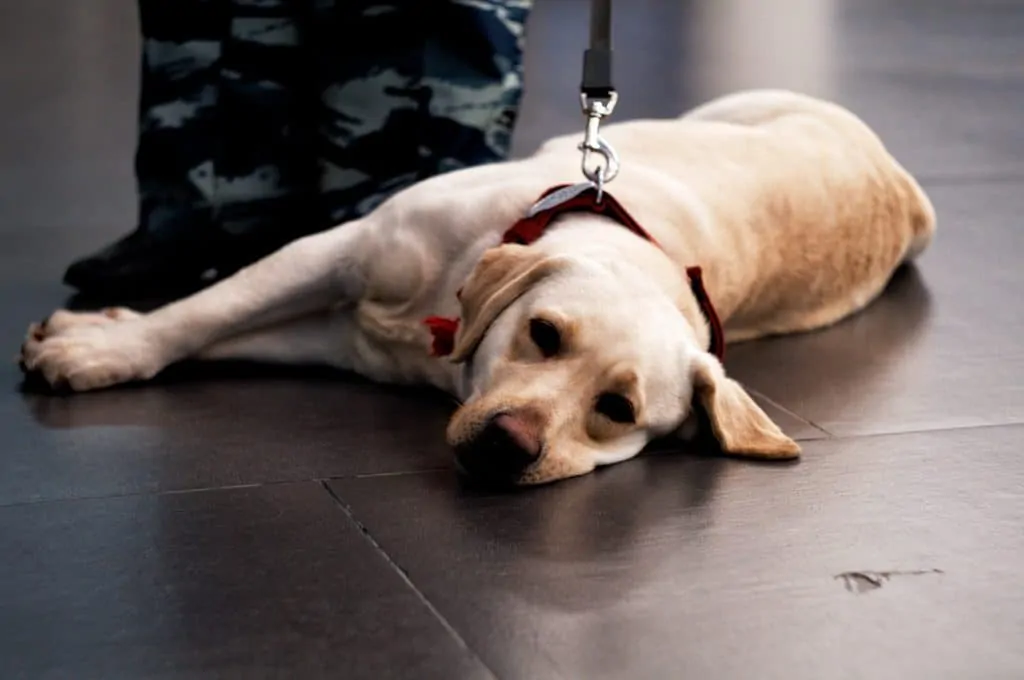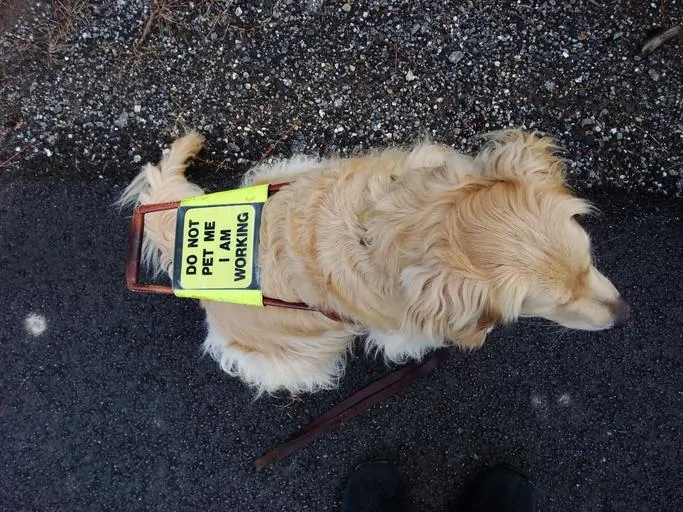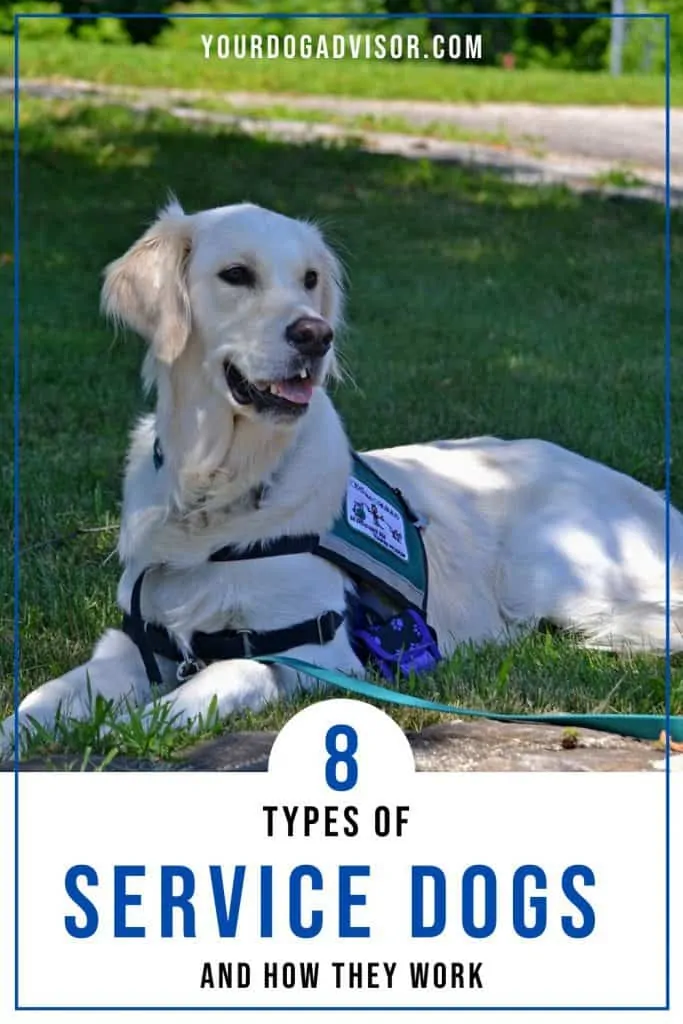Most of us have an idea about what a service dog is, but unless you’ve ever personally experienced what it is to need a service dog in your life, it can be difficult to understand just how impactful and life-changing these canines can be.
When we think of the different types of service dogs, many of us think of guide dogs or therapy dogs. But did you know there are actually eight different types of service dogs currently recognized?
Join us today as we take a closer look at these eight different types of service dogs that only our most intelligent canine counterparts can fill, and learn why these special dogs are more than just man’s best friend.
Let’s get started!
Contents
The Incredible Science Behind Different Types of Service Dogs
It can take up to two years to properly train a service dog.
Dogs are some of the oldest domesticated animals on the face of the earth, with evidence suggesting that domestication of dogs spans back nearly 4,000 years.
Since then, people and dogs have created a bond unlike any other interspecies relationship on the planet. In fact, studies have found that dogs are the only animal to actively seek out eye contact from their human counterparts, and that dogs love us just as much as we love them.
The more we learn about dogs, the more we understand why our bond with them is so much deeper than friendship. Having a relationship with a dog is a relationship unlike any other. It is non judgemental, full of unconditional love, and riddled with consistency. And you know we humans love our consistency.
But there is something else amazing that dogs do. They help us in ways no other animal can both physically and mentally. In fact, dogs are so successful at helping us humans cope with certain disabilities and ailments that there are now a certified 8 types of service dogs we can turn to for assistance.
So, how do different types of service dogs work?
According to an article posted by Mental Health America, just being around dogs helps decrease levels of cortisol, also commonly referred to as the stress hormone. In fact, dogs are responsible for helping not only to decrease our stress, but they also increase the level of oxytocin in our brains. And yes, oxytocin is the happy hormone.
Dogs are so intune with us, researches say, that they are actually impacted by our moods, habits and overall lifestyle. And their ability to be so intune with human beings is what makes them so excellent at helping those of us who are most in need.
Incredibly, dogs can actually smell our emotions, detecting subtle changes in hormone levels that tell them if we are anxious, happy, sad, or angry. Similarly, they can also smell disease, the impending episode of a panic attack, detect seizures sometimes hours before they occur, and assist the hearing and visually impared live normal, happy lives.
Of course, while all dogs are amazing and incredible in their own way, not every dog can join the ranks of the below types of service dogs. Serious training goes into these types of service dogs and for good reason.
Curious to learn more?
Let’s go over the eight different types of service dogs and then talk a bit about the most common types of dogs that are lucky enough to be employed as such.
1. Guide Dogs
Guide dogs help provide independence to their visually impared or blind human partners.
Service Performed: Help guide the visually impared
Training Requirements: 12 to 24 Months
Perhaps the first thing many of us think of when we think of different types of service dogs are guide dogs. Guide dogs, or seeing eye dogs, as they are often called, are dogs who help assist those who are visually impared.
Generally, guide dog training begins in a puppy’s youth and puppies go through 12 to 24 months of rigorous training. They are often fostered by volunteers who want to assist these dogs in their service employment.
Unfortunately, not all seeing eye dogs who enter training pass the test. Those who do pass are then matched with their new human counterparts, who further go on to learn how to work with these types of service dogs.
But training doesn’t end there. Most guide dogs continue with training throughout their lives to ensure they are the best they can be.
Dogs who do not pass their training often go on to enjoy a regular doggy life and are none the wiser.
2. Hearing Assistance Dogs
It can take up to two years to properly train a hearing assistance dog.
Service Performed: Alerting people who are hard of hearing of important sounds
Training Requirements: 1 to 2 years
Hearing assistance dogs play an important role for their human family members. These dogs can be trained to perform up to 40 tasks and are able to physical alert their human partners of important sounds including fire alarms, smoke alarms, carbon monoxide detectors, as well as more mundane sounds like the microwave or doorbell.
Unlike seeing eye dogs, these types of service dogs (hearing dogs, we mean) are not able to help guide their owners safely across the street and are not trained to do other tasks like alert their owners to medical emergencies like seizures.
However, their role is just as important and many hearing assistance dogs have been credited over the years for saving their owners lives.
Just as with seeing eye dogs, training for hearing assistance dogs takes anywhere from one to two years. During this time, those dogs who do not pass are able to go on to be adopted by people simply looking for a doggo companion.
The dogs that do pass are then matched to a human partner whom they are able to assist in helping live a happy, healthy, and more independent life.
3. Diabetic Alert Dogs
Diabetic alert dogs can help catch low blood sugar levels in their humans before it becomes dangerous.
Service Performed: Detect blood sugar levels before they become dangerously low
Training Requirements: At Least 2 Years
Let’s Learn More
Diabetic alert dogs, unlike some other types of service dogs, can take a bit longer to train and prepare for such a serious and important task. These dogs are responsible for detecting low blood sugar levels in their humans before these levels become dangerous, and as such these dogs need to be specifically matched with an individual person.
For the first year or so of a Diabetic Alert Dog’s training, this canine typically lives with a foster family as it undergoes classes. In the second year, (depending on the program) these dogs are then matched to an applicant who requires their assistance.
During this next year, these types of service dogs are trained using specific swabs of the applicant’s saliva, and are trained to detect their specific hormone levels and DNA. These dogs then know what is a normal, healthy blood sugar level and what is not simply through the power of smell.
4. Seizure Response Dogs and Seizure Alert Dogs
Seizure response and seizure alert dogs perform two different types of tasks.
Seizure Alert Dog Service Performed: Detect seizures before they occur
Seizure Response Dog Service Performed: Help with seizures during or after they occur
Training Requirements: 2 Years
A Seizure Alert Dog and a Seizure Response Dog are two different things. Each dog is trained to do something different, though there are instances where you can have a dog who can perform both tasks.
When it comes to medical alert dogs like seizure response and alert dogs, training is not taken lightly. Again, these dogs require at least two years of intensive training before they can be employed as these types of service dogs.
Depending on the dog and the level of the dog’s training, these types of service dogs may be able to detect a seizure before it happens and direct their human partner to a safe location. Seizure response dogs are generally there to assist during or after a seizure by pressing a button that calls for help, or performing some other task to ensure their human is safe.
Other seizure alert and response dogs may be trained to assist with mobility issues and are taught to retrieve items for their humans like the phone, medication, and even answer the door or turn on a light.
5. Mobility Assistance Dogs
Mobility assistance dogs must often be large and muscular.
Service Performed: To help provide more independence for those with mobility issues
Training Requirements: 18 – 24 Months
Let’s Learn More These Types of Service Dogs
Generally, mobility assistance dogs are larger and are therefore able to perform more strenuous tasks to assist their human counterparts in everyday life.
Some of these tasks include providing balance support and stability, helping people get dressed or undressed, pushing buttons on automatic doors or elevators, picking up dropped possessions, helping to carry bags or other items, getting the phone, answering the door, and getting up and down the stairs.
People who most benefit from these types of service dogs are those who suffer from arthritis, cerebral palsy, brain injury, coordination issues, impaired balance, muscular dystrophy, fibromyalgia, spina bifida, vertigo, spinal cord injury, or other neurological issues.
Like other types of service dogs on this list that perform medical or assistance services, mobility assistance dogs can sometimes take up to two years to train before they are then carefully matched to a particular human partner.
6. Autism Support Dogs
Autism support dogs provide a great deal of support to those who struggle with autism.
Service Performed: Helping adults and children with autism cope and thrive
Training Requirements: 2 Years
Let’s Learn More These Types of Service Dogs
Autism support dogs provide a number of services for their human counterparts, including providing mobility support, de-escalate emotional or self-harming behaviors, and reducing agitation or anxiety.
For adults and children who struggle with autism, these types of service dogs provide constant companionship that is non-judgemental, safe and loving.
Children especially tend to benefit from autism support dogs, though their parents are generally the handlers of these types of service dogs.
When it comes to children with a service dog in the home, it’s important that other family members are careful not to try and build a close bond with the dog.
While this can seem harsh and is often difficult, the reason is simple. These types of service dogs must see their person in need as their sole focus so that they better perform their duties.
As with other types of service dogs on this list, autism support dogs require up to two years of training before being matched with an applicant. Further training is then going to ensure the dog and the applicant are happy and cohesive together.
7. Allergy Detection Dogs
Allergy detection dogs, like many service dogs, accompany their human counterparts in day-to-day life.
Service Performed: Keep their vulnerable human safe from potentially deadly allergy attacks
Training Requirements: 18 Months to Two Years
Let’s Learn More These Types of Service Dogs
Allergy detection dogs may be the lesser known types of service dogs out there, but they are by no means less important. These dogs have saved countless lives simply by using their incredible sense of smell.
Allergy detection dogs use those amazing noses of theirs to sniff out potentially harmful substances that could cause deadly allergies and anaphylaxis to their human counterparts. The most common people who utilize the help of these types of service dogs are those who suffer from serious nut allergies, medical allergies, gluten allergies, and more.
These types of service dogs accompany their humans in everyday life, using their sense of smell to detect and alert their human if a harmful substance is near. They are trained to take an alert pose, thus helping to communicate that danger is nearby.
Some allergy alert dogs can also be trained on how to press certain buttons for help, alert someone nearby that their human is in danger, and even retrieve medication like a life-saving epinephrine auto-injector or epipen.
8. Psychiatric Service Dogs
Psychiatric assistance dogs are especially helpful to those suffering from PTSD, making them excellent companions for those who have suffered trauma.
Service Performed: Assist with emotional support and reduce anxiety, stress, panic attacks and depression
Training Requirements: 1 to 2 years
Let’s Learn More These Types of Service Dogs
Also referred to as emotional support dogs, psychiatric service dogs are an incredibly important part of society. They assist with all sorts of mental health and wellness issues including depression, PTSD, anxiety disorders, sleep disorders, eating disorders, and more.
While these types of dogs do not always need to undergo the intensive training as some types of service dogs, they should still be trained with basic ques to help assist their human counterparts in need.
Some tasks psychiatric service dogs can be trained to perform include initiating cuddling during a panic attack, reminding their people to take scheduled medications, assisting with room checks for those suffering from PTSD after violent experiences, disrupting self-harming behavior, alleviating or de-escalating emotional breakdowns, and helping assist their people if they become disoriented.
The 10 Most Popular Service Dog Breeds In The World
The Golden Retriever is one of the most common service dogs in the world.
While any mix, mutt and breed can be trained to be types of service dogs, not every dog is ideal for performing every task. In fact, there are some types of service dogs who are simply bred for the job, and those types of service dogs are listed below.
Take a look!
The Labrador Retriever
The labrador Retriever is currently the most popular dog to own in the United States, and for good reason. This breed is highly intelligent and trainable, and he makes a fabulous family companion.
Due to his clever mind and trainability, the Lab is also a fantastic service dog. He gets on well with people of all ages and is eager to please, quick to learn, and enjoys having a job to do.
Some of the types of services this dog performs include:
- Assistance Dog
- Drug Sniffer Dog
- Search and Rescue Dog
- Pest Control Sniffing Dog
The German Shepherd
Ther German Shepherd is the second most popular dog in America, according to the American Kennel Club. Loyal, alert, and incredibly trainable, the hard-working German Shepherd is also one of the most sought after service dogs in the world.
Originally bred as a herding dog in Germany, today’s German Shepherd performs a number of tasks and is employed for several different types of service dog duties, which we’ve listed below.
- Police Dog
- Military Dog
- Seizure Alert Dog
- Guide Dog
The Greyhound
Let’s be honest. When you think of types of service dogs, you probably didn’t think about the Greyhound. But actually, the Greyhound is incredibly people-oriented and very intune with his human counterparts.
In fact, he is so intune that he makes for a natural companion to those suffering from anxiety, depression, sleep disorders, and Post Traumatic Stress Disorder.
The services the Greyhound provides best include:
- Emotional Support Dogs
- PTSD Support Dogs
The Saint Bernard
We love ourselves some Saint Bernard doggos. These pups are incredibly sweet and stunningly beautiful. More importantly, they play an incredible role when it comes to the types of service dogs on this list.
The Saint Bernard may not be known for his incredible snout or his ability to provide military or police services, but this dog is still a life saving canine. In fact, he is most commonly employed in search and rescue missions and has a natural, heroic nature about him, as you can see from his main position listed below.
- Search and Rescue Dog
The Rottweiler
The beautiful but imposing Rottweiler is another dog that tends to surprise those who are looking into different types of service dogs. This large, muscular breed was once considered fearsome and aggressive, but he is really a big marshmallow when properly trained and socialized.
In fact, the rottweiler today sits at number 8 out of 196 on the American Kennel Club’s list of most popular dog breeds. Not only that, but he is also a popular service dog, performing the below tasks:
- Police Dog
- Military Dog
The Beagle
Did you ever think you would find the Beagle here on our list of types of service dogs? While this may come as a surprise, the Beagle is actually a scent hound bred for hunting. This working dog breed has an incredible snout and works closely with officers at airports and sometimes even at crime scenes.
What is the task he performs best? Take a look:
- Scent Detection Service Dog
The Poodle
The Poodle is known just as much for his incredible coat as he is for his genuine intelligence. This brainy breed is a loyal, loving, athletic working dog who is able to play many roles when it comes to types of service dogs.
Standard Poodles especially are larger breeds who are well built and muscular, making them ideal for performing difficult and sometimes strenuous tasks.
Which types of services does the Poodle provide us with? We have listed them below.
- Mobility Assistance Dog
- Medical Alert Dog
- Guide Dog
- Hearing Dog
The Pomeranian
When most people think about the different types of service dogs, they rarely think about the Pomeranian. Small, cute, and almost teddy bear-like, the Pomeranian is more famous for looking like a living stuffed animal than for his service dog abilities.
However, this little fellow plays a major role when it comes to different types of service dogs, providing assistance to those in need ranging from mental health, hearing impairment, and even medical assistance.
- Medical Alert Dog
- Hearing Dog
- Emotional Support Dog
Border Collie
Seeing as he is one of the most intelligent dogs in the world, it’s no surprise that the Border Collie is here as one of the most common types of service dogs. A workaholic, the Border Collie does best with a job to do, and he therefore thrives when given the opportunity to help his human counterparts.
Because of his diversity, eagerness to please and willingness to learn, the Border Collie excels at a number of service positions which include:
- Search and Rescue Dog
- Seizure Alert Dogs
- Anxiety Service Dogs
- PTSD Service Dog
Golden Retriever
Last but not least we have the Golden Retriever. In fact, the Golden Retriever is arguably the most popular dog when it comes to different types of service dogs on this list. Versatile and intelligent, the Golden Retriever is capable of almost any position, providing emotional, medical, and guidance support to those in need.
The only downfall of the Golden Retriever when it comes to different types of service dogs is that this good boy is a heavy shedder. For this reason, many breeders and service dog companies have turned to breeding Goldendoodles in an effort to reduce shedding but maintain the incredible benefits of both the Poodle and Golden Retriever.
Some of the most common tasks the Golden Retriever performs when it comes to services include:
- Guide Dog
- Hearing Dog
- Medical Alert Dog
- Psychiatric Support Dog
And there you have it. Those are the different types of service dogs and the most common dogs who perform those duties.
Now it’s your turn. What do you think about these incredible canines? Leave us your thoughts about the different types of service dogs and how they work in the comment section below.
Thanks for reading!


Jen Jones is a professional dog trainer and behavior specialist with more than 25 years of experience. As the founder of ‘Your Dog Advisor’ and the ‘Canine Connection’ rehabilitation center, she applies a holistic, empathetic approach, aiming to address root causes rather than merely treating symptoms.
Well known for her intuitive and compassionate approach, Jen adopts scientifically-proven, reward-based methods, encouraging positive reinforcement over punishment. Jen specializes in obedience training, behavior modification, and puppy socialization. Her innovative methods, particularly in addressing anxiety and aggression issues, have been widely recognized. Jen has worked with many of the world’s leading dog behaviorists and in her free time volunteers with local animal shelters and rescue groups.


